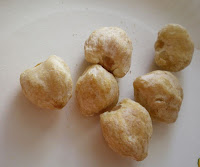
Gado-gado is a traditional dish in Indonesian cuisine, and comprises a vegetable salad served with a peanut sauce dressing. It is widely served in hotels and restaurants in Indonesia, and in Indonesian restaurants in other countries. We can also find this dish as street food around the cities in indonesia as favorite food of indonesian peoples.
The exact composition of the vegetable salad varies, but usually comprises some mixture of
* shredded or chopped green vegetables such as cabbage, watercress, and bean sprouts, sliced vegetables such young boiled jack fruit, string bean, bitter melon, and cucumber;
* tofu;
* tempeh;
* sliced boiled potatoes; and
* peeled and sliced boiled eggs.
* boiled corn (Jakarta style).
The eggs and potatoes are boiled. Only the cucumber is raw. The rest of the vegetables should be blanched. Some cooks prefer to steam the vegetables.
In addition to the vegetables, several kinds crackers and fried onion are needed. One of the most important ingredient is Limo lime. Without this lime, gado-gado does not have the smell of a real gado-gado, at least for the Jakarta style gado-gado.
What distinguishes gado-gado from a plain vegetable salad is the peanut sauce dressing, which is poured on top of the vegetable salad before serving. The composition of this peanut sauce varies as well. One may use a commercial Indonesian peanut sauce or satay sauce, or make the sauce oneself. For making the sauce, the common primary ingredients are:
* ground fried peanuts with most of the oil drained off
* coconut sugar/palm sugar (can substitute brown sugar)
* chilies (according to taste).
* limo lime juice (this is indispensible).
* terasi (dried shrimp/fish paste)
* tamarind water.
 Ingredients ;
Ingredients ;400g (2 cups)Potatoes, peeled and cubed
120g (1 cup)Beansprouts
120g (1 cup)Chinese cabbage, coarsely shredded
120g (1 cup)Long beans
3 tablespoons Oil
50g (1 3/4 cup)Soy bean cake (tempeh)
300g (1 cup)Firm beancurd
120g (1/2 cup)Cucumber, sliced into finger lengths
5 leaves Chinese lettuce, washed and dried
2 Hard boiled eggs, peeled and halves
12 Fried prawn crackers
Dressing;3 tablespoons Ground dried red chilies
100g (1 cup)Shallots
7 cloves Garlicc
1 teaspoon Shrimp paste (belacan)
2 tablespoons Water
2 tablespoons Oil
500 ml water
2 tablespoons Vinegar
1 1/4 teaspoons Salt
5 tablespoons Sugar
300g (2 cups) Roaster peanute, crushed
Method : *Boil the potatoes until firm and tender, then drain and divide between four serving bowls.
*Blanch the beansprouts for 10 seconds, remove and plunge them briefly into ice cold water. Repeat for the cabbage.
*Drain both well and divide between each bowl.
*Cut long beans to finger lengths then boil until tender and place in e ach bowl.
*Heat the oil in a pan or wok and fry the tempeh on both sides until brown.
*Remove and drain on kitchen towel, cube then place in each bowl.
*Pat the beancurd dry with paper towel and fry in the oil until brown on both sides.
*Remove and cut into cubes and divide between the four bowls.
*Divide the remaining vegetables into each bowl and top with half an egg.
*Prepare t he dressing and pour over the vegetables.
*Garnish with the prawn cracker.
How To Prepare *Blend the dried chilies, shallots, garlic and shrimp pate with 2 tablespoons water until smooth.
*Heat the oil and sauté the blended ingredients until fragrant.
*Add the water, vinegar, salt, sugar and peanuts and bring to the boil.
*Reduce the heat and simmer for another 10 minutes.



























